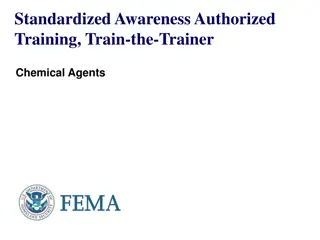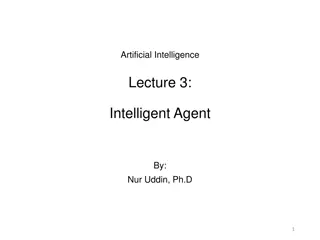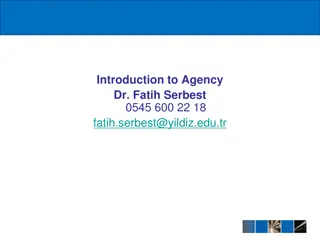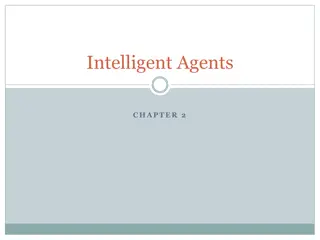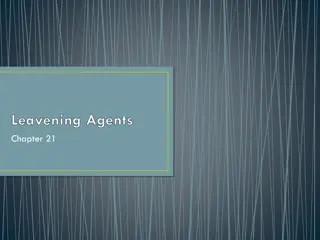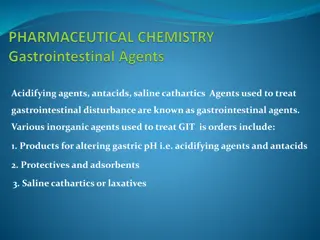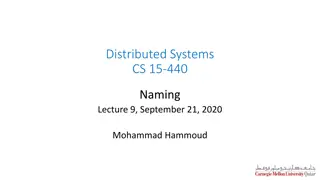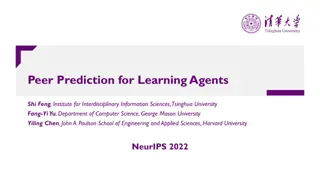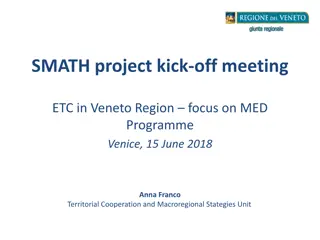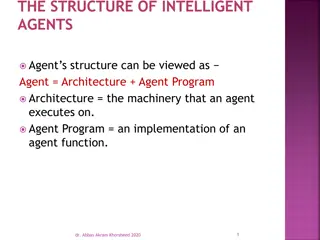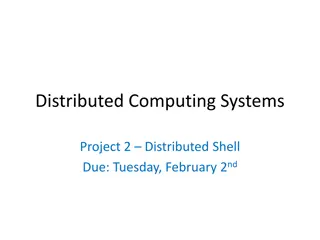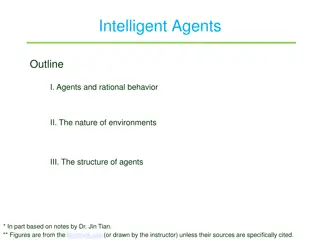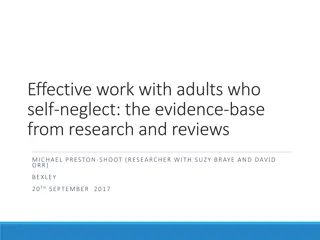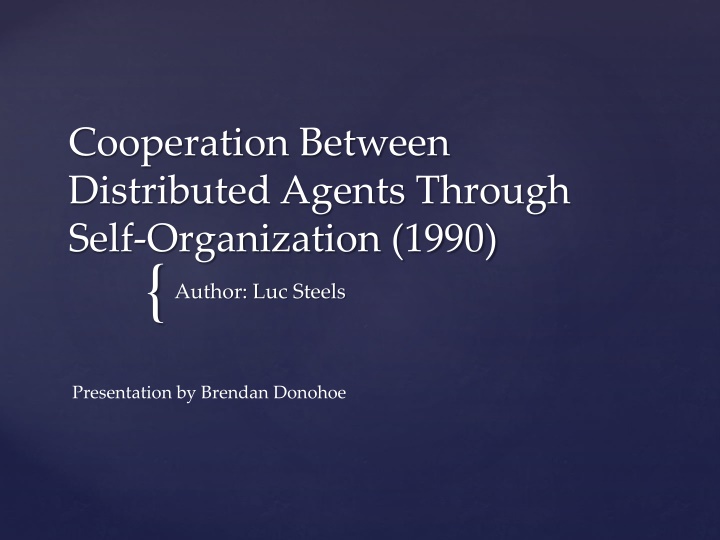
Cooperation Between Distributed Agents Through Self-Organization
Luc Steels discusses the challenge of collecting rock specimens on a distant planet using a spacecraft and mobile robots. Evaluation criteria include robustness, flexibility, and cognitive economy. Two approaches - logical and behavioral - are explored in solving this complex problem, highlighting the technological complexities and practical considerations involved.
Download Presentation

Please find below an Image/Link to download the presentation.
The content on the website is provided AS IS for your information and personal use only. It may not be sold, licensed, or shared on other websites without obtaining consent from the author. If you encounter any issues during the download, it is possible that the publisher has removed the file from their server.
You are allowed to download the files provided on this website for personal or commercial use, subject to the condition that they are used lawfully. All files are the property of their respective owners.
The content on the website is provided AS IS for your information and personal use only. It may not be sold, licensed, or shared on other websites without obtaining consent from the author.
E N D
Presentation Transcript
Cooperation Between Distributed Agents Through Self-Organization (1990) { Author: Luc Steels Presentation by Brendan Donohoe
The Problem We ve landed a spacecraft containing a large vehicle and a finite number of m mobile robots (whose design and behaviors are left to our discretion) on a distant planet. We wish to collect n samples of a particular rock specimen and bring them back to Earth on the spacecraft. We do not know the layout of the terrain, but we know that it s fairly rough, with several obstacles, hills, valleys, etc. to navigate around. We do not know the location of the samples, but know that they tend to be distributed in clusters. How do we assess the quality of a particular solution to this problem?
Evaluation Criteria Robustness. Graceful performance degradation. Flexibility. Hardware economy. Cognitive economy. Communicative economy. Predictability. Prior knowledge. Time.
Logical Approach Each robot builds a logical representation of the world using logical predicates and variables. Each is equipped with an inference machine to use rules of inference to reason about their world. Robots communicate with one another or the vehicle using logical formulae.
Logical Approach (contd) Example: left-of(object-1, object-2) sample(object-1) big-mountain(object-2)
Logical Approach (contd) Technological complexity: such an agent needs several megabytes of memory with a processor capable of executing tens of thousands of logical inferences per second (about the power of a large 1990 workstation). Would need to extract a full logical representation of the world from a robot s sensors. Several other problems (frame problem, reasoning in time and space, handling sudden changes to the world in each robot s logical representation, etc). Largely impractical!
Behavioral Approach Through a set of predefined behaviors, robot reacts to the environment around it. Does not require a complete, complex model of the world and other robots. Use an analogical representation of the world instead of a logical one (e.g., a two-dimensional matrix whose entries denote the positions objects occupy in the world). Can no longer use logical inference to reason about the world, but much closer to what is received from the sensors and can be operated upon much more easily.
Behavioral Approach (contd) In the behavioral case, functionality is not typically explicitly preprogrammed by the developer, but emerges as a so-called dissipative structure . A dissipative structure is another term for emergent behavior some phenomenon which emerges as a result of the specific programmed interactions of the robot with the world around it.
First Attempt at a Solution Create two main behavior modes, grouped under a subsumption architecture. Random (Movement/Handling) behavior: If you sense a sample and are not carrying one, pick it up. If you sense the vehicle platform and are carrying a sample, drop it. Otherwise, move in a random direction. 1. 2. 3. Obstacle Avoidance: If you sense an obstacle in front, make a random turn. 1.
First Attempt at a Solution (contd) Robust? Yes failure of the sensors and actuators for some particular robot will not lead to further malfunction of the system. Flexible? Yes changes in the environment have extremely little bearing on the state of the system. Cognitive economy? Yes no complex internal representations of the world are necessary. Communicative economy? Yes there is no information that needs to be exchanged between robots. Bonus: free parallelism! Time? Uh
First Attempt at a Solution (contd) (The locations of robots, robots carrying samples, samples, and collected samples, respectively.) Ran simulation on a 10 x 10 grid with n = 100 samples, all concentrated at one location, and number of robots m = 8, 16, , 256. (Each second, a robot moves to an adjacent grid square?) Robots bring the samples back to the vehicle, located at a single square.
First Attempt at a Solution (contd) Took about 30000 s to collect all samples for m = 8, and decreased to about 8000 s for m = 256. Observed that parallelism significantly reduced the time for a given sample to be collected by a robot brought down to 200 s in the m = 256 case, but had no effect on the amount of time for the sample to be brought back to the vehicle once collected this instead remained constant at about 7800 s.
Second Attempt at a Solution Can t treat the time to return to the vehicle by just increasing the number of robots. Idea: add a gradient field, centered at the location of the vehicle (the gradient field is treated more as a scalar field than a vector field in this paper, i.e. no direction, only magnitude), whose values decay with distance (e.g. emitting a series of sound waves from the vehicle). Robots can now explore by following a direction of decreasing gradient. Robots can use the field to navigate their way back once they have collected a sample. Robots can also use the magnitude of the field at their current location to judge their distance from the vehicle, and return if they stray too far. If the vehicle were to move, the robots could move with it.
Second Attempt at a Solution (contd) Now have two additional behavior modes: Return movement: If you are in return mode, choose the direction of highest gradient. 1. Explore movement: If you are in exploration mode, choose the direction of lowest gradient. 1. Mode determination: If I am in exploration mode and I sense no lower concentration than the concentration in the cell on which I am located, I put myself in return mode. If I am in return mode and I am at the vehicle-platform, I put myself in exploration mode (and drop the sample). If I am holding a sample, I am in return mode. If I do not detect the field, I engage in random movement. 1. 2. 3. 4.
Second Attempt at a Solution (contd) (First image denotes the location of gradient, subsequent images show robot positions with respect to time. There are no samples in this simulation.)
Second Attempt at a Solution (contd) We see that the time for the robots to collect a given sample follows a similar trend to the previous case, only the amount of time for a robot to retrieve a sample has been reduced to virtually nothing.
Third Attempt at a Solution We would like to reduce the amount of time it takes for each robot to locate a sample. Take advantage of the fact that samples are distributed in clusters. Idea: have each robot drop crumbs if they are carrying samples. Robots that detect crumbs will be attracted toward those paths. Have robots that carry no samples pick up crumbs. Similar to the role of pheromone in Ant Colony Optimization.
Third Attempt at a Solution (contd) We add new functionality to our existing behavior modes: If you carry a sample, you drop two crumbs. If you carry no sample and crumbs are detected, you pick up one crumb. 1. 2. And add a new one: Path attraction: If you are not carrying a sample and you sense crumbs, move toward the highest concentration of crumbs. 1.
Third Attempt at a Solution (contd) (Pictures show robots in the process of finding the sample, establishing the path, depleting the sample completely, and breaking the path down afterward.)
Third Attempt at a Solution (contd) Significant improvement in the amount of time for all the samples to be located and brought back to the vehicle about 2500 s for m = 8 to slightly under 1000 s for m = 128.
Conclusions Robustness. Graceful performance degradation. Flexibility. Hardware economy. Cognitive economy. Communicative economy. Predictability. Prior knowledge. Time.
References Steels L, 1990. Cooperation between distributed agents through self organization In: Demazeau Y and Muller JP (eds.) Decentralized Al Proceedings of the First European Workshop on Modelling Autonomous Agents in Multi-Agent Worlds (MAAMAW-89), pp 175 196, Elsevier.


